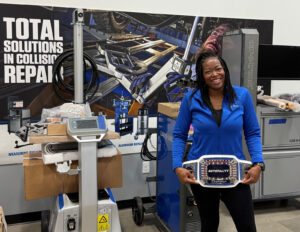Vehicle lifts are required equipment in just about every automotive service facility, whether it’s for collision repair, a tire shop, or maintenance and repair shop. Regular preventative maintenance is crucial for your teams safety, operational efficiency, and extending the life of your investment. Ignoring maintenance can lead to very costly repairs, equipment failure, and avoidable safety risks. In this maintenance guide, our equipment service department team covers essential preventative maintenance tips for various types of automotive lifts, why it matters, how to stay ahead of it, track your scheduled maintenance and much more.

Why Preventative Maintenance Matters
Scheduled preventative maintenance is essential for protecting your equipment investment while also ensuring the safety and efficiency of your shop. Regular maintenance helps prevent costly downtime caused by unexpected failures, which could otherwise disrupt your operations and lead to unnecessary expenses. By proactively addressing potential issues, you can avoid breakdowns that might have been easily prevented with routine servicing.
In addition to keeping your equipment in peak working condition, scheduled maintenance enhances workplace safety by reducing the risk of accidents and ensuring that all safety systems function as intended. A well-maintained lift provides consistent performance and reliability, allowing mechanics to service vehicles without the worry of unexpected malfunctions. Over time, this proactive approach extends the lifespan of your equipment, ultimately saving money and providing long-term value for your business. Whether it’s your vehicle lifts, frame repair equipment or even your shop compressor, preventative maintenance matters!
Daily Checks before a Lift is Used
Keeping your automotive lift in good working order starts with daily, visual and operational inspections to catch potential issues early.
- Check for any Signs of for Hydraulic Leaks
- Check around hoses, fittings, and cylinders for leaks.
- Look around the bay or floor, to see if there are any signs that fluid has leaked or dripped.
- Check the fluid reservoir to assure it at the manufacturers suggested capacity.
- Check Safety Locks and Mechanical Stops
- Test the lift’s locking mechanisms at various heights.
- Ensure locks engage properly and are free from damage or excessive wear.
- Visual Inspection of Lift Arms and Pads
- Look for cracks, bending, or excessive wear on lift arms and pads and assure you record any issues so it can be compared on future inspections..
- Replace worn pads when they reach the replacement threshold to avoid vehicle damage or slipping off the pad itself when a vehicle is raised.
- Listen for Unusual Noises During Operation
- Before ever lifting a vehicle, raise and lower the equipment to observe and listen for any odd noises or sounds that are abnormal.
- Grinding, popping, or slow operation can indicate underlying mechanical issues.
Weekly and Monthly Maintenance
In addition to your daily checks, weekly and monthly maintenance is necessary to keep lifts in top condition. We suggest you check the following at least weekly, if not more often
- Lubricate Moving Parts
- Pivot points, bearings, and cables should be lubricated regularly to reduce wear and maintain smooth operation.
- Inspect and Tighten Fasteners
- Vibration and constant use can cause bolts and fasteners to loosen. Tighten any loose components.
- Check Cables and Pulleys
- Look for fraying, kinks, or corrosion on lift cables. Replace them at the first sign of wear.
- Test Electrical and Hydraulic Systems
- Ensure electrical connections are secure and free of corrosion.
- Check hydraulic pressure and fluid levels.
Annual Inspections
While daily and weekly maintenance can help prevent many issues, it is crucial to have your lifts professionally inspected at least once a year by a trained and authorized service professional. Routine professional inspections go beyond surface-level checks, ensuring that your equipment remains in optimal working condition and complies with manufacturer recommendations.
Certified technicians conduct thorough diagnostics, identifying potential problems that may not be immediately visible. They perform hydraulic system tests to verify that pressure and seals are functioning within their designed tolerances, as well as electrical system checks to detect worn wiring and confirm secure connections. Additionally, they replace worn parts or provide a list of components that need attention, helping you address minor wear before it escalates into costly, unexpected failures.
Keep a Detailed Maintenance Log
Document every inspection, repair, and maintenance task performed on your lifts. This log helps track equipment needs, spot any kind of trends, and comply with safety regulations that may be required by insurance companies.
Need professional equipment inspections or repairs? Contact the Autotality service and installation department for expert service and consultation.




